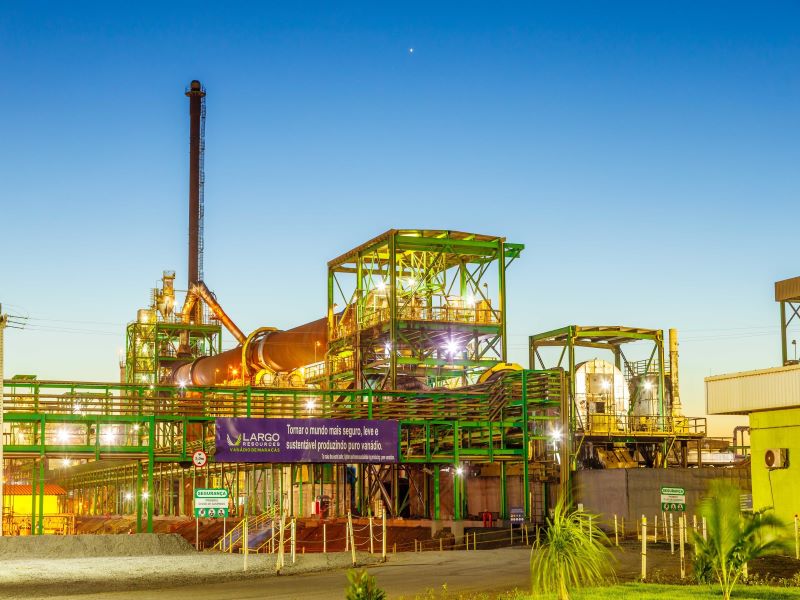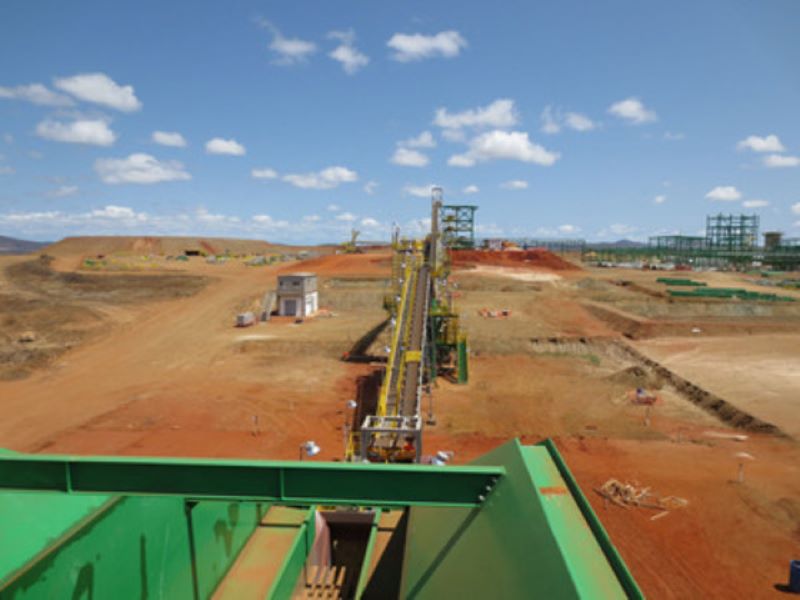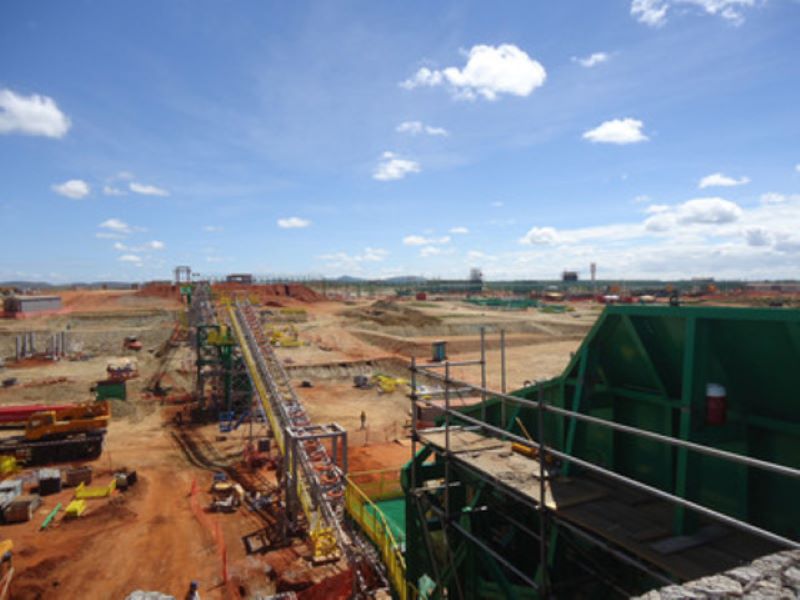The Maracás Menchen mine is a high-grade vanadium mine located in the state of Bahia, Brazil. Operated by Largo, a Canadian producer of vanadium products, it is the only vanadium mine in Latin America.
The mine was commissioned in 2013, with initial mining operations commenced on the Gulçari A Deposit, which is now known as the Campbell Pit. The first vanadium pentoxide (V2O5) from the mine was produced in August 2014.
Largo filed a technical report including an updated life of mine plan for the Campbell Pit and a pre-feasibility study (PFS) for the expansion of operations to include the Novo Amparo Norte (NAN) and Gulçari A Norte (GAN) deposits in December 2021.
The report highlighted an extension of the mine life to 20 years with operations expected to commence in 2022 and last until 2041.
Project location and geology
The Maracás Menchen mine is located approximately 250km southwest of Salvador in the greater municipality of Maracás in Bahia State in eastern Brazil. The property covers an area of 17,690ha.
The deposits at the mine are hosted in the Rio Jacaré intrusion within the Archean São Francisco craton, which comprises the Contendas-Mirante Complex and the Gavião and Jequié blocks. The Rio Jacaré mafic-ultramafic intrusion is a linear sheet-like structure, mainly comprising gabbro with an almost north-south strike, with a length of 70km and an average width of 1.2km.
Mineralisation and reserves
The mineralisation at the Maracás Menchen mine includes magnetite layers or magnetite pyroxenite layers formed as cyclic magmatic units. The vanadium mineralisation is hosted within titaniferous magnetite, which is the primary oxide phase within the Maracás Menchen deposits. The titanium mineralisation is found in ilmenite, which forms a secondary oxide phase.
The proven and probable mineral reserves of the Maracás Menchen mine were estimated at 60.36 million tonnes (Mt) grading 0.79% V2O5 and 8.24% titanium dioxide (TiO2), as of October 2021.
Mining at Maracás Menchen mine
The mining fleet comprises four Volvo EC750 hydraulic excavators equipped with a bucket capacity of 2.5m³ and 24 Scania 8×4 36-tonne capacity trucks. The drilling fleet includes six Sandvik Ranger DX800 rotary drill rigs.
The future mining operations will involve the use of conventional open-pit mining methods including drilling, blasting, loading and hauling. A contract mining fleet of hydraulic excavators, front-end loaders, and 36t haul trucks will be used to support the operation.
The open-pit mining will focus on extracting ore from the Campbell pit, as well as NAN and GAN deposits. The mine plan is based on a dilution of 3% for Campbell with 100% recovery, and a 5% dilution for GAN and NAN deposits with a recovery rate of 95%.
The mine production rate is estimated at 1.7 million tonnes per annum (Mtpa) for the first ten years from the Campbell Pit, followed by 5Mtpa from GAN and NAN deposits for the remainder of the mine life.
Phased expansion of Maracás Menchen mine
The mine development has been divided into four phases. To be undertaken between 2022 and 2023, the phase one development will involve the construction of a 150,000 tonnes per annum (tpa) ilmenite concentration plant and a 30,000tpa TiO2 pigment processing plant.
The phase two development between 2024 and 2025 will expand the pigment processing plant and the vanadium trioxide (V2O3) plant.
The titanium pigment processing plant to be commissioned in phase two will produce TiO2. The process will involve drying and milling, digestion and black liquor filtration, ferrous sulphate (FeSO4) crystallisation, hydrolysis, calcination, and surface treatment. The resulting material will be washed, filtrated and dried before micronisation using high-pressure steam to produce the final TiO2 product.
The phase three development, which is planned between 2026 and 2028, will involve the expansion of the titanium pigment plant to 120,000tpa and the ilmenite concentration plant to 425,000tpa, as well as site preparation for the commencement of mining at the GAN and NAN deposits. The phase four development planned between 2029 and 2032 will involve and commencement of mining at GAN and NAN.
The first ten years of production from 2022 to 2031 will involve 100% plant feed from the Campbell Pit. The vanadium plant will be fed with material from Campbell Pit, GAN, and NAN from 2032. The plant feed from 2033 to 2041 is expected to be a blend of approximately 45% from GAN and 55% from NAN.
Ore processing
Commissioned in 2014, the vanadium recovery plant at the project site achieved its nameplate capacity in 2018. An expansion project was implemented in 2019, which increased the processing capacity to 1.9Mtpa of run-of-mine (ROM) and the production capacity of V2O5 to 12,000tpa.
The current processing comprises three-stage crushing, single-stage grinding, two-stage magnetic separation, vanadium leaching, magnetic concentrate roasting, ammonium meta-vanadate (AMV) precipitation, AMV filtration, and AMV calcining processes. The final stage includes fusing V2O5 into flakes or screening it to produce powder as final product.
The ROM is processed by a three-stage crushing circuit comprising a primary jaw crusher, two cone crushers and two vibrating sizing screens. The crushed product is fed to a dry magnetic separator before being introduced to the milling circuit comprising two ball mills in series.
The milled material is transferred to a low-intensity magnetic separation (LIMS) circuit, which comprises one rougher and two cleaner stages. The final magnetic concentrate is filtered and stockpiled to be fed to the roasting section of the plant. The non-magnetic concentrate is thickened and pumped to the non-magnetic tailings pond. It will be fed to the ilmenite flotation plant after the proposed phase one expansion.
The flotation circuit produces an ilmenite concentrate, which is filtered in a horizontal filter to produce a filtered concentrate with 10% moisture. The ilmenite concentrate can be sold or used in the future TiO2 pigment plant to be built in Camacari.
The filtered magnetic concentrate from the LIMS circuit is afterwards roasted in a rotary kiln to produce a calcined material containing sodium vanadate.
The calcined material is ground in a ball mill and leached before being sent to a thickener. The thickened product is filtered and washed using a vacuum belt filter to produce a filter cake containing 10% moisture, 60% iron, 2.9% silicon dioxide (SiO2) and 6.8% TiO2, which is stockpiled in a pond at the mine site.
The discharged solution, known as dirty pregnant solution from the vacuum belt filter containing approximately 110g/l V2O5, is pumped to the chemical plant to undergo desilication to produce a pregnant leach solution (PLS). The PLS is sent to the precipitation circuit to produce an AMV precipitate which is filtered, washed and dried before being calcined to produce V2O5 powder.
A crystallisation circuit is used to process the barren leach liquor containing ammonium sulphate, sodium sulphate and small quantity of dissolved AMV and impurities. The liquor is concentrated by evaporation and pumped to a cyclone where the underflow feeds a centrifuge. The wet AMV containing 15% solids is dried and calcined to produce V2O5, which is melted and cast into flakes for sale.
The wet AMV from the precipitation belt filter will be separated into two flows, upon the commissioning of the V2O3 plant. One flow will be sent to a flash dryer, while the second flow will be fed to the new V2O3 reaction plant, which includes a flash dryer and a rotary kiln to transform the AMV into V2O3.
Off-take agreement
A sales contract was executed with an undisclosed steel producer for the supply of 14,000t of iron ore from the Maracás Menchen mine, in March 2021.
Project infrastructure
The project is accessible via a 29km-long paved secondary highway, west from Maracás, and then a 20km gravel road, which leads to a ranch where the project is located. The Campbell Pit is accessed via a 2.5km-long sand and gravel trail.
The power required for the operations is sourced via an 85km-long 138kV transmission line from Brazilian electric utility Coelba’s Ibicoara regional substation. The electrical infrastructure at the project site includes a 13.8kV step-down substation and two 13.8kV 15/15 MVA power transformers.
Raw water is supplied from Rio de Contas River and a lake formed by the Pedra Dam through a 35km-long pipeline to two 1,000m3 concrete tanks on the Maracás site.
Contractors involved
The 2021 PFS for the project was prepared by GE21 Consultoria Mineral (GE21), an independent mineral consulting firm based in Brazil.
Largo has an ongoing mining fleet contract with Minax, a Brazilian mining services company. The contractual scope also includes the operation of Campbell Pit.






